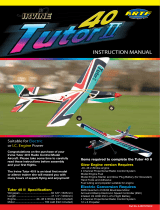
STEP 44
Remove the rudder slot film with searing iron. Insert two hinges into the rudder,ensuring they are
located mid-way in their slots. Using thin cyano,pour a couple of drops onto each hinge-above and
below-ensuring the glue soaks into the hinge and surrounding wood. Install the rudder to the fin to
check the tail wheel wire bend position.
STEP 45
Bend the tail wheel wire with vice and stick the wire to the rudder hole.
STEP 46
Now slide the rudder in place making sure that both hinges are located in their slots in the fin and
that the tailwheel wire fits neatly into tis recess in the rudder. Wipe off any excess epoxy. Ensure
that the rudder is aligned to the top of the fin and there is free movement left and right plus a
gap-free hinge line. Now apply a couple of drops of thin cyano to each side of each hinge taking
care not to allow the adhesive to run through the gap onto the other side of the model. Then install
the tapping screws to the tail-board again.




















